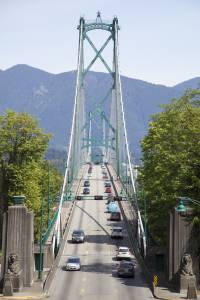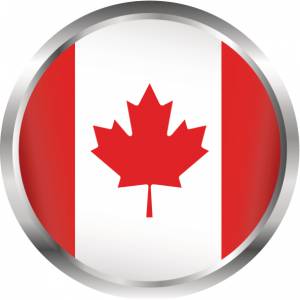
Lion Gates Bridge is an attractive spot for couples looking to maximize their Vancouver Honeymoon fun.
Although there are many exotic locations around the world in which to spend your honeymoon, Canada offers a number of great places that are romantic and fun after the stress of a wedding. Flying domestic is typically much less expensive than taking an airplane to an international destination, making it good for your budget. If you’ve never experienced the lovely city of Vancouver, here are seven places to visit on your Vancouver honeymoon, anniversary or just a romantic getaway.
Great Vancouver Honeymoon Spots
- Capilano Suspension Bridge – The suspension bridge has been a main attraction in Vancouver since 1889, and many other features have been added to the landmark over the years. Walk across the bridge that sits 70 meters above the river and experience a view that is unlike any other. Take the cliffwalk or the treetops adventure to see all the rainforest has to offer. Don’t forget to take in the Story Centre, which is an educational feature that explores the fine details of the bridge.
- Stanley Park Horse-Drawn Tours – Who wouldn’t enjoy a horse-drawn carriage ride through many different famous settings in Vancouver? Private tours for two people are available, or you can join a group of even more people to see the red-cedar forest, the Rose Garden, the Lions Gate Bridge and some of the most iconic statues in the area.
- Sun Yat-Sen Classical Chinese Garden – The first classical Chinese garden in Canada is a perfect place to find peace and romance when you walk through the covered walkways and pavilions. Enjoy a jade green pond filled with koi fish, miniature trees, and tai hu rock. Have a cup of traditional Chinese tea before you leave.
- Vancouver Art Gallery – Take in some culture while you’re on vacation at a world-renowned museum. If you’re into photography, you’ll find a huge collection of works from Ansel Adams, Cindy Sherman and Henri Cartier-Bresson. The gallery also has a collection of paintings by Emily Carr, who is known for a modernistic style influenced by the local indigenous peoples of B.C.
- Science World – This museum may be known as a place for children to explore the scientific world, but adults can enjoy the exhibits and see how science and art collides. The Geodesic dome is a beautiful piece of architecture that should be admired. The museum periodically hosts adult-only events. Check the calendar to find dates and plan your trip accordingly.
- Queen Elizabeth Park – Even if you’re not into floral displays and horticulture, Queen Elizabeth Park offers stunning views in a romantic setting where you and your partner can talk and connect. The park sits 152 meters above sea level and is the highest point in Vancouver. It features native and exotic trees and beautiful sculptures as well as recreational activities.
- BC Place – The stadium is the home of the Vancouver Whitecaps and BC Lions, but it also hosts many different special events throughout the year. The retractable roof is a technological wonder, and if you ever get a chance to see this venue, you should definitely take advantage of it.
Vancouver offers many styles of hotels, from the most modern with all the bells and whistles to classical bed and breakfasts outfitted in antique décor. If you enjoy shopping, you’ll find a plethora of different stores featuring local designers and artisans to find the perfect souvenirs of your trip. If you’re into sports, Vancouver has a full selection of summer and winter sports venues. Enjoy the ocean or the mountains, both in the same day should you choose. You can’t go wrong when you take a trip to Vancouver to see all it has to offer.



